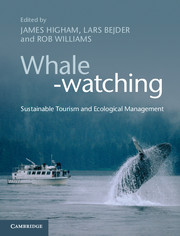Book contents
- Frontmatter
- Dedication
- Contents
- Acknowledgements
- List of contributors
- List of abbreviations
- 1 Tourism, cetaceans and sustainable development
- Part I The historical and contemporary contexts
- Part II Human dimensions of whale-watching
- 7 The whaling versus whale-watching debate
- 8 Iceland and the resumption of whaling
- 9 Green messengers or nature's spectacle
- 10 Whale-watching
- 11 What's in it for the whales?
- 12 Integrating traditional ecological knowledge and community engagement in marine mammal protected areas
- Part III Ecological dimensions of whale-watching
- Part IV Sustainable management: insights and issues
- Index
- Plate Section
- References
10 - Whale-watching
An effective education programme is no fluke
from Part II - Human dimensions of whale-watching
Published online by Cambridge University Press: 05 April 2014
- Frontmatter
- Dedication
- Contents
- Acknowledgements
- List of contributors
- List of abbreviations
- 1 Tourism, cetaceans and sustainable development
- Part I The historical and contemporary contexts
- Part II Human dimensions of whale-watching
- 7 The whaling versus whale-watching debate
- 8 Iceland and the resumption of whaling
- 9 Green messengers or nature's spectacle
- 10 Whale-watching
- 11 What's in it for the whales?
- 12 Integrating traditional ecological knowledge and community engagement in marine mammal protected areas
- Part III Ecological dimensions of whale-watching
- Part IV Sustainable management: insights and issues
- Index
- Plate Section
- References
Summary
Introduction
The ocean is the largest remaining wild place on Earth, and contains populations of cetaceans (whales, dolphins and porpoises) in oceanic, coastal and river systems. Despite comprising 71% of the Earth's surface, less than 1% of the world's oceans and adjacent seas has protected status, compared to approximately 12% of the world's land area (Hoyt, 2005). Today, the oceans and their cetacean inhabitants face multiple human threats – pollution, both chemical (Wise Sr et al., 2009) and noise (Hatch et al., 2012), prey depletion (Bearzi et al., 2005), entanglements in fishing gear (Robbins & Mattila, 2004), hunting (Hovelsrud et al., 2008) and ship strikes (Panigada et al., 2006) are among the most pervasive. Now more than ever, people need to be educated about the oceans and encouraged to act on their behalf.
Humans have always had a strong connection to whales. An evolution in human attitudes and behaviour towards cetaceans has taken us from hunting them to hailing them as icons of marine conservation. Attitudes towards whales, their suffering and their death have changed dramatically over time, with a steep turnaround in the 1970s–1980s (Bearzi et al., 2010). Cetaceans are now renowned for the education opportunities they present as ambassadors, communicating the need for us to protect them and their aquatic habitats. There is no question of the allure of cetaceans and the passion they inspire in most of us. There is also little doubt that watching whales and dolphins in their natural environment offers an ideal platform to educate visitors (Orams, 1997) about the many endangered species of cetaceans, the overall health of their habitats and what can be done by individuals to help. Because of this, we believe that whale-watching is one of the best ways to combat a society increasingly alienated and distanced from nature, and an excellent chance to affect conservation-based behaviour change. The issue is not whether we have the right species or the right experience from which to capture the hearts and minds of visitors, it is are we currently planning and offering effective education programmes onboard whale-watch trips that change not only attitudes toward cetaceans and the oceans, but also behaviour?
- Type
- Chapter
- Information
- Whale-watchingSustainable Tourism and Ecological Management, pp. 128 - 145Publisher: Cambridge University PressPrint publication year: 2014
References
- 4
- Cited by

